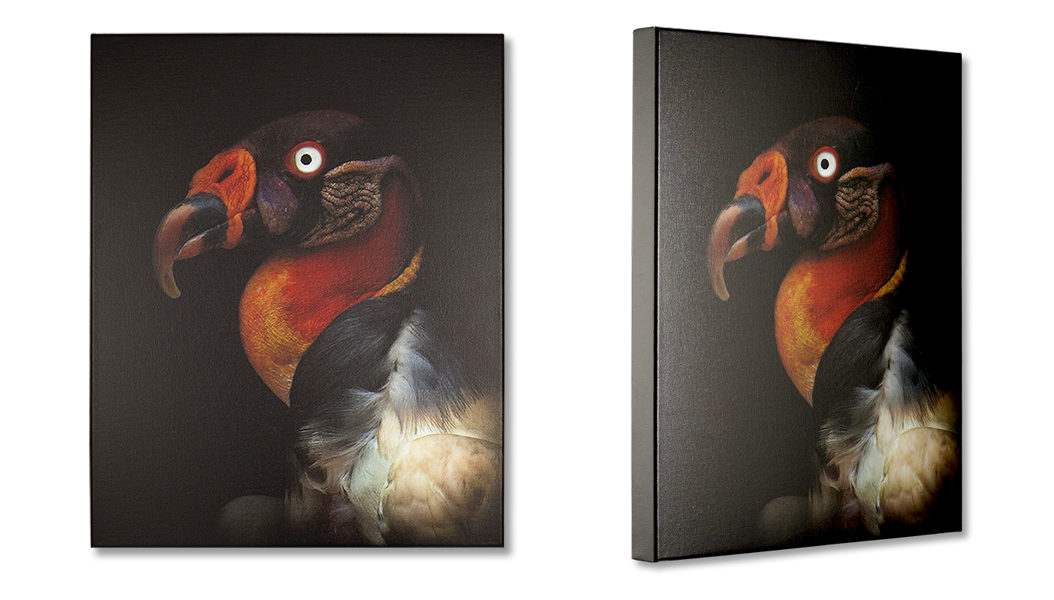01/25/2023
by Laura Gardiner
Studio Manager, Tribeca Printworks

Canvas prints are beautiful, affordable and versatile, which is why many artists and photographers print their images on canvas. You can choose a gallery or studio wrap print to display your art prints. Learn about the key differences between these two similar canvas print methods to decide which option is right for you.
What Is a Gallery-Wrapped Canvas?
With a gallery wrap canvas print, the canvas material wraps around thick, durable wooden stretcher bars. Because the canvas material folds tightly around the canvas, you can’t see the staples or fasteners used to secure the stretched canvas. Gallery-wrapped canvases are ready-to-hang, meaning they don’t require a frame if you don’t want one. However, gallery wrap canvas prints look stunning in floater frames in various shades and materials.
Most professional artists and photographers prefer a clean, ready-to-hang gallery-wrapped canvas to showcase their prints in galleries or museums.
What Is a Studio-Wrapped Canvas?
A studio-wrapped canvas also features canvas material that wraps around the canvas’s wooden stretcher bars. But unlike a gallery wrap canvas, the staples or fasteners used to secure the canvas material around the stretcher bars are often still visible. For this reason, studio-wrapped canvases are not always ready to hang — unless the designer doesn’t mind visible staples on the canvas’s borders. Otherwise, the designer must also select a frame that complements their print.
Canvas Wrap Edge Types — How to Choose the Best Wrap Edge Style
Once you select a gallery-wrapped canvas print, you must choose a wrap edge style. The wrap edge refers to the way the canvas print wraps around the back of the canvas’s wooden stretcher bars. There are several wrap edge styles to choose from, such as:
- Mirrored wrap edge: A mirrored wrap edge “mirrors” or duplicates sections of your artwork or photography to cover the canvas edges. This wrap edge gives the illusion that the print wraps around the edge of the canvas, but the full print can be seen from the canvas’s front.
- Folded wrap edge: A folded wrap edge folds your print tightly across the canvas edges. In other words, your artwork wraps around the edge of the canvas print so small sections are not visible from the front.
- Stretched wrap edge: A stretched wrap edge “stretches” your print across the canvas’s edge, giving the borders a blurry or pixelated effect. You can view the entire print on the canvas front with this wrap edge type.
- White wrap edge: A white wrap edge features a white border along the edges of your canvas print.
- Black wrap edge: Similar to the white wrap edge, a black wrap edge features a black strip around your print’s edges.
You might be unsure about which wrap edge to choose. If the edges of your artwork or photography feature essential details, it’s best to select a wrap edge style that displays the full print on the front of the canvas, such as a mirrored, black or white wrap edge. Otherwise, the wrap edge you choose depends on your preference and what you believe looks best with your print.
Canvas prints are beautiful, affordable and versatile, which is why many artists and photographers print their images on canvas. You can choose a gallery or studio wrap print to display your art prints. Learn about the key differences between these two similar canvas print methods to decide which option is right for you.
The Qualities of an Exhibition-Quality, Gallery-Wrapped Canvas Print
Whatever wrap edge you choose, gallery-wrapped prints make stunning focal points anywhere you display them, like living rooms, museums or art galleries. Whether you’re printing artwork or photography, all exhibition-quality art prints boast similar qualities, including:
- High-end canvas: To create an archival canvas print, the canvas material must be a tough, durable polyester-cotton blend with a receptor coating. A polyester-cotton blend canvas prevents shrinking and provides a high-quality print finish suitable for gallery pieces.
- Quality stretcher bars: A quality gallery-wrapped canvas must have a firm base made from a solid but lightweight material, such as maple or walnut wood. Ideally, these stretcher bars should be hand-cut and dovetail jointed to create a durable, one-of-a-kind canvas print.
- Bespoke design: An enduring, exhibition-quality gallery wrap should be taut, evenly stapled and made from high-end materials. It should also feature the wrap edge and framing solutions that complement the printed artwork or photography’s unique charm.
Choose Tribeca Printworks for Custom Gallery-Wrap Canvas Printing
To create show-stopping gallery-wrapped canvas prints, partner with Tribeca Printworks. Our high-end, polyester-cotton blend canvases and custom framing solutions create one-of-a-kind, ready-to-hang canvas prints that stand out wherever you place them.
For over 40 years, the Tribeca Printworks team has helped artists, photographers and hobbyists choose canvas printing and framing solutions that complement their art and photography. We’ll assist you with all your canvas giclee art needs, from selecting a canvas size to choosing a frame that meets your stylistic preferences and budget.
Contact us online today to learn more about our canvas giclee print solutions, request a free quote or schedule a complimentary consultation with one of our consultants. When you order over $100, you’ll receive free shipping on your canvas art prints!

